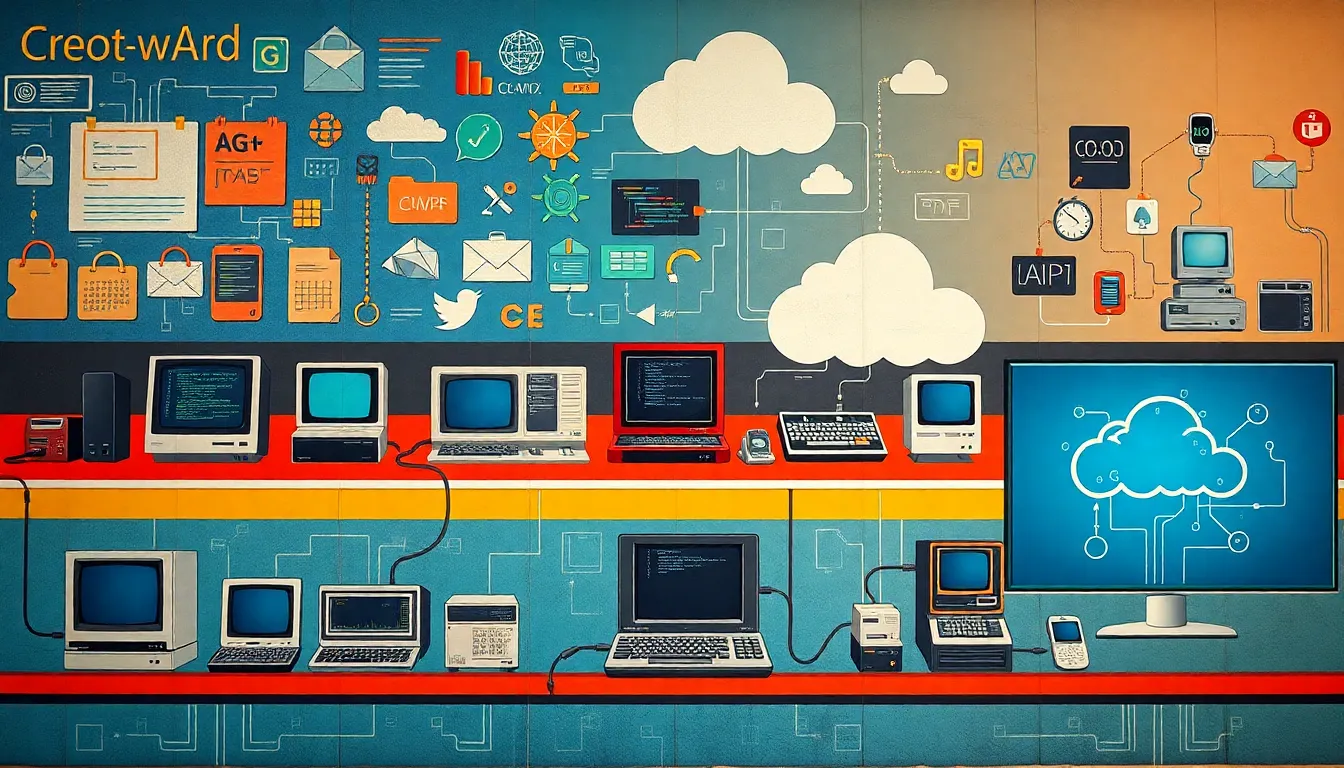Table of Contents
ToggleIn today’s fast-paced digital world, software technology shapes how people live, work, and connect. From mobile apps that streamline daily tasks to complex algorithms driving artificial intelligence, software is at the heart of innovation. Understanding these technologies unlocks endless possibilities for individuals and businesses alike.
Exploring software technology reveals not just its practical applications but also the creativity and engineering that fuel its development. Whether someone is a seasoned developer or a curious beginner, diving into this field can lead to exciting opportunities and insights. Embracing software technology is more than just keeping up with trends; it’s about harnessing the power to create solutions that improve lives.
What Is Software Technology?
Software technology encompasses the tools, methods, and processes used to create, manage, and maintain software applications and systems. This sector plays a crucial role in advancing innovation and solving complex problems.
Definition and Scope
Software technology refers to the design, development, implementation, and maintenance of software solutions. It includes programming languages, development frameworks, application software, system software, and platforms. Its scope extends to various fields, such as web development, mobile applications, and enterprise systems. Major components include:
- Programming Languages: Examples include Java, Python, and C#, utilized for software development.
- Development Frameworks: Frameworks like Angular, React, and .NET streamline the creation of applications.
- Software Development Life Cycle (SDLC): The SDLC consists of distinct phases: planning, analysis, design, implementation, testing, and maintenance.
Importance in Today’s World
Software technology plays a vital role in modern society, impacting various sectors, including education, healthcare, finance, and entertainment. Its importance includes:
- Enhanced Efficiency: Automation of tasks reduces time and resource expenditure.
- Improved Communication: Software enables efficient communication through instant messaging, video conferencing, and social media platforms.
- Data Management: Software tools allow for the effective collection, analysis, and storage of vast amounts of data, driving informed decision-making.
- Economic Growth: The software industry contributes significantly to global economies, creating millions of jobs and fostering innovation.
As software technology evolves, it continues to shape how individuals and businesses operate, making it essential for stakeholders to stay informed and engaged with these developments.
Evolution of Software Technology

Software technology has undergone significant transformations since its inception, continuously reshaping the landscape of computing and its applications. Understanding these changes highlights the pathway of innovation in the sector.
Key Milestones
- 1950s: Early Programming Languages
Assembly language and FORTRAN emerged, laying the foundation for future programming efforts.
- 1960s: Structured Programming
Introduction of structured programming techniques improved code organization and readability, enhancing software reliability.
- 1970s: Software Engineering as a Discipline
The establishment of software engineering principles aimed to address the rising complexity of software projects, promoting rigorous development processes.
- 1980s: Personal Computing Revolution
Launch of personal computers brought software technology to the masses, driving demand for user-friendly applications.
- 1990s: Internet Boom
Growth of the internet forced software developers to pivot towards web-based applications, leading to innovations in browser technologies.
- 2000s: Open Source Movement
Rise of open source software enabled collaborative development, facilitating wider adoption and customization of software solutions.
- 2010s: Cloud Computing
Transition to cloud services transformed how software applications are deployed and accessed, paving the way for scalability and flexibility.
- 2020s: AI and Machine Learning
Integration of artificial intelligence and machine learning has revolutionized software capabilities, personalizing user experiences and automating complex tasks.
Impact of Advances
Software technology advancements significantly influence multiple sectors. They drive efficiency through automation in industries, enhance communication via collaborative tools, and improve data management across diverse platforms. Increased reliance on software in sectors such as healthcare leads to better patient outcomes through data analytics and tailored treatment plans. The education sector benefits from e-learning platforms, offering personalized learning experiences. Each technological leap fosters economic growth, creating new job opportunities while streamlining operational processes. Staying aware of these advancements empowers stakeholders to adapt and innovate, ensuring competitive advantages in an evolving market.
Current Trends in Software Technology
Current trends in software technology reflect rapid advancements that shape various industries. Embracing these trends leads to enhanced efficiency and innovation across sectors.
Emerging Technologies
Emerging technologies exhibit transformative potential in software development. Key areas include:
- Artificial Intelligence: AI integration automates tasks, analyzes data, and enhances user experiences. Its implementation spans customer service, healthcare diagnosis, and financial forecasting.
- Machine Learning: ML algorithms enable software to learn from data and improve over time. Real-world applications include personalized recommendations and predictive analytics.
- Blockchain: This decentralized technology ensures secure transactions and data integrity. Industries like finance and supply chain management benefit from its transparency and security features.
- Internet of Things (IoT): IoT connects devices, creating smart environments. Applications in smart homes and industrial automation enhance productivity and convenience.
- Edge Computing: Processing data closer to its source reduces latency. Utilizing edge computing benefits sectors such as transportation and healthcare with fast, real-time analysis.
Industry Applications
- Healthcare: Software technology accelerates patient record management, telehealth services, and medical diagnostics. Advanced tools facilitate better patient outcomes and operational efficiency.
- Finance: Financial institutions utilize software for fraud detection, algorithmic trading, and enhancing customer experiences. Automation in transaction processing improves accuracy and speed.
- Education: Educational software fosters online learning platforms, customization of curricula, and effective communication. Such technologies support diverse learning needs and improve engagement.
- Entertainment: Streaming services leverage software for content delivery, user recommendations, and interactive experiences. Data analytics drives viewer satisfaction and content optimization.
- Transportation: Software applications manage logistics, route optimization, and traffic analysis. Innovations in this field enhance safety and efficiency in goods and passenger transport.
Challenges in Software Technology
Challenges in software technology affect development and user experience. Notable issues include security concerns and scalability challenges, which require careful consideration.
Security Concerns
Security concerns represent a major challenge in software technology. Cyber threats, including data breaches and malware attacks, compromise sensitive information. According to a study by IBM, the average cost of a data breach reached $3.86 million in 2020. Software developers must prioritize security measures throughout the Software Development Life Cycle (SDLC). This includes adopting secure coding practices, implementing regular security audits, and utilizing encryption techniques. Organizations must also educate users about potential phishing attacks and the importance of maintaining strong passwords.
Scalability Issues
Scalability issues present another significant challenge in software technology. As user demands grow, applications must adapt to increased workloads without sacrificing performance. A report from Gartner states that organizations often incur a 25-30% increase in operational costs due to scalability problems. Engineers need to design scalable architectures that accommodate future growth, such as adopting microservices or cloud computing solutions. By effectively managing scalability, businesses can enhance user satisfaction and ensure seamless performance under varying loads.
Future of Software Technology
The future of software technology promises rapid advancements and transformative innovations. Stakeholders must remain attentive to these changes to harness opportunities effectively.
Predictions and Innovations
Predictions for software technology emphasize enhanced integration of artificial intelligence (AI) and machine learning (ML). Researchers forecast that AI-driven automation will dominate workflows, increasing productivity and reducing errors. Innovations in quantum computing may lead to breakthroughs in complex problem-solving, offering solutions not possible with current computing methods.
Trends indicate a shift towards decentralized software solutions through blockchain technology, enhancing security and transparency. Moreover, advancements in low-code and no-code platforms increase accessibility for non-developers, enabling wider participation in software creation. As smart devices proliferate, the Internet of Things (IoT) will expand, facilitating seamless communication among connected systems, thereby optimizing operations across various industries.
Potential Impact on Society
Software technology’s evolution will significantly impact societal structures. Enhanced communication tools foster global collaboration, bridging geographical gaps in business and education. Moreover, AI’s role in healthcare could revolutionize patient diagnosis and treatment personalization, improving overall health outcomes.
Urban environments may witness transformations through smart city initiatives driven by IoT, improving resource management and quality of life for residents. However, the reliance on software also raises concerns regarding job displacement, necessitating retraining programs to equip the workforce with relevant skills.
As software technology continues to develop, it offers both challenges and opportunities that will shape society’s future. Engaging with these advancements can lead to improved efficiency, innovation, and socio-economic growth.
Embracing software technology opens up a world of possibilities for innovation and efficiency. Its influence spans across various sectors, driving growth and transforming everyday tasks. As advancements continue to emerge, individuals and businesses must stay engaged and informed to harness these tools effectively.
The future promises even more integration of AI, machine learning, and other emerging technologies. This evolution will not only enhance productivity but also reshape industries in ways previously unimaginable. By prioritizing security and scalability, developers can ensure that software solutions meet the demands of a rapidly changing landscape.
Ultimately, the journey through software technology is just beginning. Those who adapt and innovate will find themselves at the forefront of a revolution that enhances lives and creates new opportunities.




